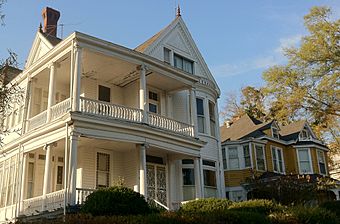Chestnut Hill–Plateau Historic District facts for kids
The Chestnut Hill–Plateau Historic District is a special old area in the Highland Park neighborhood of Richmond, Virginia. People sometimes call it 'Highland Park Southern Tip' on city maps.
This area was added to the National Register of Historic Places in 2002. It's important because it shows how neighborhoods grew when streetcars became popular. It has many homes from the early 1900s, like beautiful Queen Anne Victorian houses and sturdy American Foursquare homes.
Contents
History of Chestnut Hill–Plateau
Early Days of the Land
The land where the Chestnut Hill–Plateau historic district now stands was once a farm called 'Mount Comfort'. This farm belonged to Samuel DuVall in the 1700s. Before the American Civil War, Peter V. and Lucy Daniel owned the land that became Chestnut Hills. A successful baker named Adolph Dill owned the area known as The Plateau. This is the northeast part of the district.
Civil War Times
During the Civil War, a defense spot called Battery No. 7 was built here. It protected the northeast side of Richmond. This battery was located around what are now Juniper, Willow, and Spruce streets. The Chickahominy Bluffs Battlefield is also nearby.
How Streetcars Helped the Neighborhood Grow
In 1882, Richmond became the first city in the U.S. with a streetcar system that made money. The streetcar line in Chestnut Hill was finished in 1893. It was first known as the Richmond-Henrico Railway Company. This new transportation made it possible for northern suburbs like Chestnut Hill to grow.
In 1889, the suburb was planned out. In 1892, the 5th Street viaduct was built. This bridge connected the area to the main part of Richmond. The Northside Land Improvement Company bought the 135-acre Mount Comfort site in 1889. A few buildings were already there. Around the same time, the 150-acre Highland Park area was started north of Chestnut Hill.
Building Homes and Community
Some fancy Queen Anne Victorian houses were built around the 1890s. Real estate companies built them to attract buyers. Important places like churches also appeared. The Northside Baptist Church started in 1907. Services were held in the town hall for a year. Then, a large Gothic Revival-style building was completed. Today, it is the Fifth Street Baptist Church. Saint Elizabeth's Roman Catholic Church was built in 1923.
Many houses in the district are American Foursquare style. These are simple, two-story homes with Craftsman-style details. Many were built in small groups. They were meant for people with lower to middle incomes. These homes were built between 1910 and 1930. Their designs often came from magazines and catalog homes, like those from Sears.
The Plateau area was first a fruit-tree nursery. A. F. Mosby developed it in 1908. It helped extend the Chestnut Hill street plan.
Changes in the Neighborhood
Over time, the people living in Chestnut Hill–Plateau changed. By the mid-1960s, many new families moved into the area. By 1970, about 70% of the homes had new owners.
Since the 1970s, Chestnut Hill–Plateau has faced challenges. These are common in older inner city neighborhoods. Things like declining population and houses needing repairs caused property values to stay low. This made it hard for homes to be maintained or fixed up. The neighborhood was also affected by the decline in the U.S. housing market after 2007.
Today, groups like ACORN are working to help preserve Chestnut Hill–Plateau. They want to keep its history and community strong.
Homes and Buildings in the District
The historic district includes 659 buildings that add to its historical importance. There are also 83 buildings that do not contribute to its historic value.





